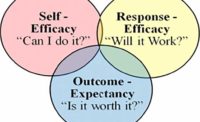Let's consider factors relevant to increasing momentum. We can return to the sports analogy for intuitive answers to the question, "How can we build and maintain momentum?" I think you'll agree from personal experience that three factors are crucial: achieving success, atmosphere of the performance environment, and attitude of the coaches and team leaders. The three ingredients start with the letter 'A,' so they are easy to remember. And you'll notice that they are clearly overlapping and interrelated.
Achievement
It's obvious that success builds success. Good performance is more likely after a run of successful behaviors than failures. In sports, a succession of winning plays or points scored creates momentum.Sports psychologists talk about momentum as a gain in psychological power - including confidence, self-efficacy, and personal control - that changes perceptions and attitudes, and enhances both mental and physical performance. It all starts with noticing a run of individual or team achievements.
So how can we apply this to safety management?
We've got to keep score. We need a system to track the small wins in safety that can build momentum. At sporting events, fans constantly check the scoreboard to measure their team's performance. 'Knowing the score' creates excitement if our team is performing well, or urgency if performance must improve. This kind of observable and fair performance measure gives the team feedback. It improves subsequent performance and increases the probability of more success and continued momentum.
To successfully manage safety, we must find ongoing objective and impartial measures of performance that allow us to regularly evaluate our progress, and motivate employees to participate in the achievement-oriented process.
This is why advocates of behavior-based safety emphasize the need to:
- develop up-stream process measures (such as number of audits completed or percentage of safe behaviors);
- set process-oriented goals that are specific, motivational, achievable, recordable, and capable of being tracked and shared;
- discuss safety performance in terms of achievement - what people have done for safety, and what additional achievement potential is within their domain of control;
- recognize individuals appropriately for their accomplishments; and,
- celebrate group or team accomplishments on a regular basis.
Atmosphere
In sports, it's called the 'home-field advantage.' It means having fans available to help create or sustain momentum. By packing the stands and cheering loudly, fans create an atmosphere that can motivate the home team to try harder. I hope the relevance to safety is clear. The atmosphere surrounding the process influences continuous participation in a safety-improvement effort.Is the work culture optimistic about the safety effort, or is the process viewed as another 'flavor of the month'?
Do workers trust management to give adequate support to a long-term intervention, or is this just another 'quick fix' reaction that will soon be replaced by another 'priority'?
Before helping a work team implement a behavior-based safety process, my partners insist everyone in the work culture learn the principles underlying the process. Everyone in the culture needs to learn the rationale behind the safety process, even those who will not be involved in actual implementation. This helps to provide the right kind of atmosphere or cultural context to support momentum.
When the vision of a work team is shared optimistically with the entire workforce, people are likely to buy in and do what it takes to support the mission. When this happens, interpersonal trust and morale builds, along with a winning spirit. People don't fear failure but expect to succeed, and this atmosphere fuels more achievement from the process team.
Attitude
The coach of an athletic team can make or break momentum. Coaches initiate and support momentum by helping both individuals and the team recognize their accomplishments. This starts with a clear statement of a vision and attainable goals. Then the leader enthusiastically holds individuals and the team accountable for achieving these goals.A positive coach can even help members of a losing team feel better about themselves, and give momentum a chance. The key is to find pockets of excellence to acknowledge, which builds self-confidence and self-efficacy. Then specific corrective feedback will be accepted as a key to being more successful, and building more momentum.
It does little good for safety leaders to reprimand individuals or teams for a poor safety record, unless they also provide a method people can use to perform better. And the leader must explain and support the improvement method with confidence, commitment, and enthusiasm.
For momentum to build and continue, support means more than providing necessary resources. It means looking for success stories to recognize and celebrate. This helps to develop feelings of achievement among those directly involved (the team) and an optimistic atmosphere from others (the work culture). These are the ingredients for safety momentum. Keep these in place and your momentum will be sustained. Then you can expect the best from your safety management efforts.
By E. Scott Geller, Ph.D., senior partner with Safety Performance Solutions, and professor of psychology at Virginia Tech. Dr. Geller and his partners at SPS develop safety management processes that build safety momentum throughout a work culture. For more information, call SPS at (540) 951-7233 (SAFE).

